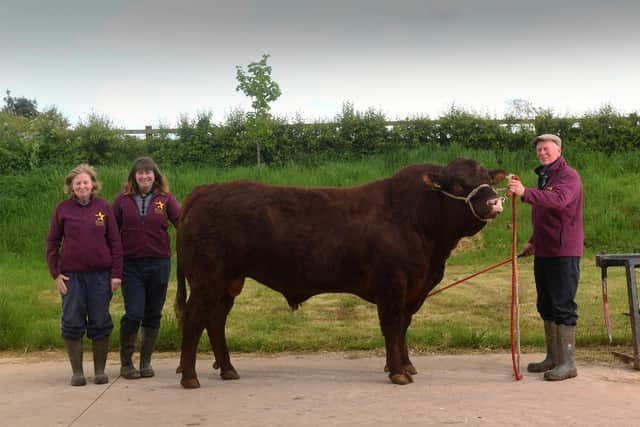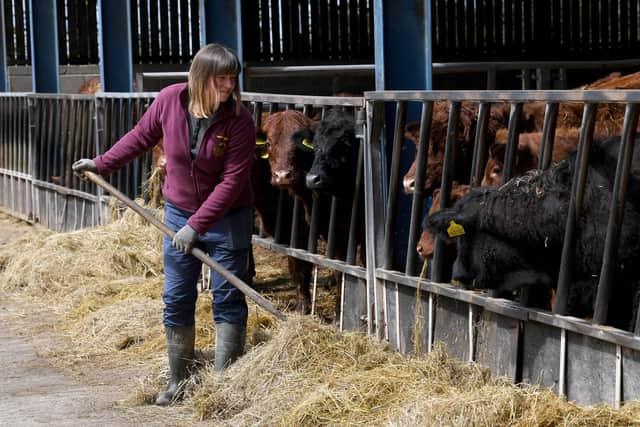Meet the former ICI steelworker who has become one of Yorkshire's cattle breeding experts
Terence Pye and his wife Jane established their Rigel pedigree herd in 1991. They took on their 210-acre Leven Fields farm at Middleton on Leven near Yarm in April 1991. Today they have a herd of 70 pedigree Salers. Terence is devoted to the breed and to its calling card attribute of easy calving.
“In terms of my experience with the breed, I always say it does what it says on the tin. It’s a breed that absolutely delivers what we were promised right at the beginning in terms of easy calving.
Advertisement
Hide AdAdvertisement
Hide Ad“I’m now very much an ambassador for calving ease within the cattle industry because I’ve come to the view that assisted calvings are virtually avoidable, that there should be very few, and yet still, most farmers regard it as a routine activity.


“This business of the Salers calving themselves has proven spectacularly successful in the increase in the breed’s number. We keep figures that go back over our 30-plus years and our Salers and Salers-crossed cows have a totally unassisted calving rate of 99.1 per cent.
“That figure includes everything from backwards calving to twins. We’ve never had a big calf stuck in a small cow, which is what lots of farmers are still pulling out. Those who are assisting a quarter to a third of their cows in calving will find it is largely because they’ve got the combination of calf size and cow pelvis wrong. That’s why they’re still having to hoik them out. It simply doesn’t need to be that way.
“I was invited to speak at the British Cattle Breeders Conference this January and that was my topic, encouraging breeders to think about choices of sire and dam to get to the 99 per cent which they should be able to.
Advertisement
Hide AdAdvertisement
Hide AdTerence says the Salers is now the UK’s eighth biggest breed in terms of breeding cattle in the UK and that it is likely to move further up the table in future, all primarily down to its pelvis size and easy calving, something that farmers with suckler herds are beginning to understand.


“It is eighth in the UK because it is such a proven crossing breed. There is a section of commercial breeders that are trying to use pure Salers, but I think producing a three-quarter Salers is better and I encourage people to keep it very much as a crossbred animal because of more hybrid vigour.
“The Golden Calf, as it’s sometimes called, is putting a Charolais bull over a crossbred or pure Salers. You get very good results with it. We ran our own commercial herd that way into the late 90s, but as our pedigree prowess grew we eventually dispersed the commercial herd and very recently dispersed what Charolais we had left to concentrate on what we do best, providing great pedigree Salers.
Terence and Jane came to the area because of his earlier career with ICI on Teesside. They had no farming background but a desire to learn and a leaning towards cattle, but with no leaning towards one particular breed.
Advertisement
Hide AdAdvertisement
Hide Ad“We started with my brother Malcolm, who had a small farm in Nottinghamshire and who now farms in Scotland. At the time it was the only way we could farm seriously, by working together. We then looked for a farm and bought Leven Fields.
“Our bread and butter business became commercial sucklers and at that stage with what people term a Heinz 57 of varieties, any old cow and a handful of pedigrees. It was upgrading to a Salers-crossed herd with a Charolais bull that got us going.
“We started a Charolais herd in 1997, but since 2018 we have been totally Salers with Hi-Health accreditation and Breedplan performance recorded. We have been showing continuously at the Great Yorkshire Show since 1994.
“More than half of the stock we sell are sold direct from the farm. It varies year to year, with the rest sold at Society Sales or other major breeding sales and multibreed sales. This spring we have sold a lot ex-farm.
Advertisement
Hide AdAdvertisement
Hide Ad“I retired from my industrial career in 2008, since then I’ve been on the farm 100 per cent.
That tells only half the story. While Terence may have already done everything for the breed society in taking on a variety of roles over the years he is also far more than a man who stays on his farm. He has been involved in a number of big issues in the cattle world recently.
“I’m there to support the breed in whichever way I can. I’ve been involved in quite a number of big issues behind the scenes, specifically helping the breed and other breeds deal with problems that rear up, some with no need.
“There has been a big furore recently about a health accreditation scheme run by CHECS (Cattle Health Certification Standards) where there were some impractical rules being implemented and breeders had to get themselves organised quickly to oppose them. I played a leading role in that.
Advertisement
Hide AdAdvertisement
Hide Ad“We were able to point out errors and enlist support from other industry figures. The health accreditation scheme management were basically saying that they wanted to advise to cull cows for Johne’s Disease on the basis of blood test results.
“The problem was that a blood test isn’t a test for Johne’s. It’s an indicator and you’re supposed to follow up with a foetal test, which is a definitive test for Johne’s. This could all have led to a loss of herd health accreditation status for Johne’s and having to cull perfectly healthy cows.
“We worked with the other breed societies and that resulted in the formation of a new group called the Pedigree Breeds Steering Group which will be a lasting thing to have come out of all this. I don’t have any involvement with it, but it came about through the breeds working together, which was a great thing.
Terence is also currently concerned that other commercial breeders should have cows without myostatin mutations that can affect muscle growth, calving and fertility.
Advertisement
Hide AdAdvertisement
Hide Ad“It’s when you get what is called this ‘double copy’ when the gene has come from both sides of the breeding, that’s when you get these humongous calves, people talk about 80 kilo calves.
“If you’re a suckler man you should have cows without these mutations – then you can use one of these myostatin bulls from a Charolais breed or whatever safely because the cow’s got a big pelvis and not got reduced fertility or reduced milk, so there’s a new model emerging of females. With Salers you largely only get 30-35 kilo calves.